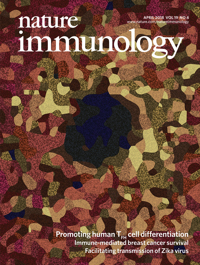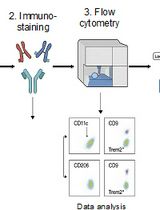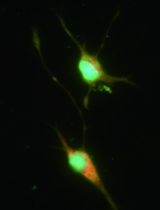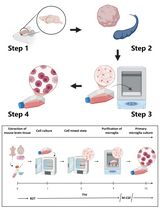- EN - English
- CN - 中文
Isolation and Culture of Mouse Lung ILC2s
小鼠肺ILC2s的分离和培养
发布: 2018年10月05日第8卷第19期 DOI: 10.21769/BioProtoc.3032 浏览次数: 10207
评审: Ruth A. FranklinFrancesco BorrielloXiaoping Xie
Abstract
Group 2 Innate Lymphoid Cells (ILC2) play an important role in immune responses at barrier surfaces, notably in the lung during airway allergic inflammation or asthma. Several studies have described methods to isolate ILC2s from wild-type naive mice, most of them using cell sorting to obtain a pure population. Here, we describe in detail, a simple, efficient method for isolation and culture of lung mouse ILC2s. Lungs from Rag2-/- mice pretreated with IL-33 are collected and processed into single cell suspensions. Lymphoid cells are then recovered by density gradient separation. Lin-CD45+ cells are selected by depletion of lineage positive cells followed by positive selection of CD45+ cells. Culture of the isolated cells for several days results in a highly purified ILC2 population expressing typical cell surface markers (CD90.2, Sca1, CD25, CD127, and IL-33R). These cells can be expanded in culture for up to 10 days and used for diverse ex vivo assays or in vivo adoptive transfer experiments.
Keywords: Innate immunity (先天免疫)Background
Group 2 Innate Lymphoid Cells (ILC2) are tissue resident cells that play crucial roles in anti-parasitic innate immunity as well as in the development of allergic inflammation. They respond to epithelial cell-derived cytokines such as interleukin-33 (IL-33) by producing large amounts of type 2 cytokines IL-5 and IL-13, which in turn induce eosinophilia and mucus production (Cayrol and Girard, 2018). In order to better characterize the function and regulation of these cells, numerous groups have sorted ILC2s from the lung of wild-type mice (WT) by fluorescence-activated cell sorting (FACS). Due to the low number of the ILC2s present in the lungs at steady state, this method results in a low yield of purified cells (1 x 104 per mouse) (for a review, see Moro et al., 2015). In the present protocol, we pretreat mice with IL-33, which triggers the in vivo expansion of lung ILC2s, resulting in a better yield of purified cells (1.3 x 106 per mouse). Moreover, we use Rag2-/- mice instead of WT mice because 1) the absence of B and T cells in these mice facilitates the purification of ILC2s, and 2) the number of ILC2s is greater in these mice. Culture of the isolated Lin-CD45+ cell population for a couple of days ex vivo provides highly purified lung ILC2s without the need to use a cell sorter. In summary, the procedure we describe is highly reproducible and provides abundant highly purified mouse lung ILC2s.
Materials and Reagents
- Sterile disposable scalpel (LABELIANS, NahitaTM, catalog number: SCMEC24 )
- 96-Well polystyrene conical bottom MicroWellTM Plates (Thermo Fisher Scientific, catalog number: 249570 )
- 15 ml and 50 ml conical centrifuge polypropylene tubes (Corning, Falcon®, catalog numbers: 352096 and 352070 respectively)
- 5 ml round-bottom polystyrene tubes (Corning, Falcon®, catalog number: 352054 )
- Cell culture 60 x 15 mm Petri dishes (Thermo Fisher Scientific, catalog number: 150288 )
- 1 ml tuberculin syringes (with 25 G x 16 mm disposable) (Terumo, catalog number: SS-01T )
- BD Micro-Fine+TM Insulin Syringes 0.3 ml; 30 G x 8 mm needle (BD, catalog number: 324826 )
- 70 μm cell strainer (Corning, Falcon®, catalog number: 352350 )
- Plunger of 2.5 ml syringes (Terumo, catalog number: SS*02SE1 )
- Hypodermic needles (Terumo, catalog number: NN-2516R )
- Non cottoned open Pasteur pipettes (150 mm 2 ml) (Hilgenberg, catalog number: 3150102 )
- MS columns (Miltenyi Biotec, catalog number: 130-042-201 )
- 6-well polystyrene (PS) multidish (Thermo Fisher Scientific, catalog number: 140675 )
- 1.2 ml Cluster Tubes loose (Thermo Fisher Scientific, Abgene®, catalog number: AB-0672 )
- Rag2-/- mice on a C57BL/6J background (B6.129-Rag2tm1Fwa) (European Mouse Mutant Archive [EMMA])
- Human recombinant Interleukin-33 (rIL-3395-270), natural form (home-made; previously described in Lefrançais et al., 2014)
Note: Alternatively, recombinant IL-33 can be purchased from R&D Systems (R&D Systems, catalog number: 3625-IL ). - Ice
- Dulbecco's Modified Eagle Medium (DMEM, high glucose, GlutaMAXTM Supplement, pyruvate) (Thermo Fisher Scientific, GibcoTM, catalog number: 31966021 )
- Dulbecco's Phosphate-Buffered Saline (DPBS, no calcium, no magnesium) (Thermo Fisher Scientific, GibcoTM, catalog number: 14190169 )
- RPMI 1640 with high glucose, L-Glutamine, HEPES (ATCC, catalog number: 30-2001 )
- Penicillin/Streptomycin 100x liquid (Thermo Fisher Scientific, GibcoTM, catalog number: 15140122 )
- 2-Mercaptoethanol (Sigma-Aldrich, catalog number: M3148 )
- Recombinant mouse IL-2 (Cys 160 Ser) Protein (R&D Systems, catalog number: 1150-ML-020 ; Reconstitute at 100 μg/ml in sterile DPBS containing 0.1% bovine serum albumin. Store stock solution at -70 °C)
- Collagenase Type IV (Thermo Fisher Scientific, GibcoTM, catalog number: 17104019 )
- DNase I, from bovine pancreas (Roche Diagnostics, catalog number: 11284932001 )
- Fetal Bovine Serum (Thermo Fisher Scientific, GibcoTM, catalog number: 10270-106 )
- Normal mouse serum (Thermo Fisher Scientific, catalog number: 10410 )
- Lympholyte®-M (CEDARLANE, catalog number: CL5035 )
- EasySepTM mouse hematopoietic progenitor cell isolation kit (STEMCELL Technologies, catalog number: 19856 )
- CD45 MicroBeads, mouse (Miltenyi Biotec, catalog number: 130-052-301 )
- FACS reagents
Note: Dilutions have to be determined for each lot of reagent.
- Fixable Viability Dye eFluor 506 (dilution: 1/1,000) (Thermo Fisher Scientific, eBioscienceTM, catalog number: 65-0866-14 )
- Streptavidin, PE-CyTM 7 conjugated (dilution: 1/100) (BD PharmingenTM, catalog number: 557598 )
- FACS Monoclonal Antibodies
Note: Dilutions have to be determined for each lot of antibody.- Rat anti-Mouse CD16/CD32 (mouse BD Fc BlockTM) (clone 2.4G2, dilution: 1/200) (BD PharmingenTM, catalog number: 553142 )
- Rat Anti-Mouse CD4, FITC conjugated (clone GK1.5, dilution: 1/2,000) (Thermo Fisher Scientific, eBioscienceTM, catalog number: 11-0041-85 )
- Rat Anti-Mouse CD3, FITC conjugated (clone 17A2, dilution: 1/600) (Thermo Fisher Scientific, eBioscienceTM, catalog number: 11-0032-80 )
- Rat Anti-Mouse CD19, FITC conjugated (clone 1D3, dilution: 1/2,000) (BD PharmingenTM, catalog number: 553785 )
- Rat Anti-Mouse CD45R/B220, FITC conjugated (clone RA3-6B2, dilution: 1/1,000) (BD PharmingenTM, catalog number: 553088 )
- Hamster Anti-Mouse CD11c, FITC conjugated (clone N418, dilution: 1/300) (Thermo Fisher Scientific, eBioscienceTM, catalog number: 11-0114-82 )
- Rat Anti-Mouse CD11b, FITC conjugated (clone M1/70, dilution: 1/100) (Thermo Fisher Scientific, eBioscienceTM, catalog number: 11-0112-85 )
- Rat Anti-Mouse Ter119, FITC conjugated (clone Ter119, dilution: 1/100) (Thermo Fisher Scientific, eBioscienceTM, catalog number: 11-5921-85 )
- Rat Anti-Mouse Ly-6G/Ly-6C, FITC conjugated (clone RB6-8C5, dilution: 1/100) (Thermo Fisher Scientific, eBioscienceTM, catalog number: 11-5931-85 )
- Hamster Anti-Mouse FceR1α, FITC conjugated (clone MAR-1, dilution: 1/100) (Thermo Fisher Scientific, eBioscienceTM, catalog number: 11-5898-85 )
- Mouse Anti-Mouse NK1.1, FITC conjugated (clone PK136, dilution: 1/300) (Thermo Fisher Scientific, eBioscienceTM, catalog number: 11-5941-85 )
- Rat Anti-Mouse CD45, PerCP conjugated (clone 30-F11, dilution: 1/1,000) (BD PharmingenTM, catalog number: 557235 )
- Rat Anti-Mouse CD90.2, APC-CyTM7 conjugated (clone 53-2.1, dilution: 1/600) (BD PharmingenTM, catalog number: 561641 )
- Rat Anti-Mouse CD25, eFluor 450 conjugated (clone PC61.5, dilution: 1/300) (Thermo Fisher Scientific, eBioscienceTM, catalog number: 48-0251-82 )
- Rat Anti-Mouse CD127, PE conjugated (clone A7R34, dilution: 1/100) (Thermo Fisher Scientific, eBioscienceTM, catalog number: 12-1271-83 )
- Rat Anti-Mouse Ly-6A/E (Sca-1), APC conjugated (clone D7, dilution: 1/300) (Thermo Fisher Scientific, eBioscienceTM, catalog number: 17-5981-83 )
- Rat Anti-Mouse T1/ST2 (IL-33R), biotinylated (clone DJ8, dilution: 1/100) (MD Biosciences, catalog number: 101001B )
- FACS Isotype controls
Note: Isotype controls are used at the same concentration as the specific antibody. So, dilutions have to be determined according to the concentration of the matched antibody.- Rat IgG1 κ Isotype Control, eFluor 450 (clone eBRG1, dilution: 1/300) (Thermo Fisher Scientific, eBioscienceTM, catalog number: 48-4301-80 )
- Rat IgG2a κ Isotype Control, APC (clone eBR2a, dilution: 1/300) (Thermo Fisher Scientific, eBioscienceTM, catalog number: 17-4321-81 )
- Rat IgG2a, κ Isotype Control, PE (clone eBR2a, dilution: 1/100) (Thermo Fisher Scientific, eBioscienceTM, catalog number: 12-4321-82 )
- Rat IgG2a, κ Isotype Control, APC-CyTM 7 (Clone R35-95, dilution: 1/600) (BD PharmingenTM, catalog number: 552770 )
- Rat IgG1, κ Isotype Control, Biotin (Clone R3-34, dilution: 1/50) (BD PharmingenTM, catalog number: 553923 )
- Lung digestion solution (see Recipes)
- PEF buffer (see Recipes)
- PEB buffer (see Recipes)
- ILC2 culture medium (see Recipes)
- FACS buffer (see Recipes)
- FACS staining buffer (see Recipes)
Equipment
- MiniMACSTM separator (Miltenyi Biotec, catalog number: 130-042-102 )
- EasySepTM Magnet (STEMCELL Technologies, catalog number: 18000 )
- Malassez Hemocytometer
- Water bath
- Centrifuge (Eppendorf, model: 5804 R )
- 4 °C refrigerator
- Flow cytometer (BD, model: LSR I I)
Software
- FlowJo software (Tree Star)
- BD FACSDivaTM software (BD Biosciences)
Procedure
文章信息
版权信息
© 2018 The Authors; exclusive licensee Bio-protocol LLC.
如何引用
Schmitt, P., Duval, A., Mirey, E., Girard, J. and Cayrol, C. (2018). Isolation and Culture of Mouse Lung ILC2s. Bio-protocol 8(19): e3032. DOI: 10.21769/BioProtoc.3032.
分类
免疫学 > 免疫细胞分离 > 淋巴细胞
细胞生物学 > 细胞分离和培养 > 细胞分离
您对这篇实验方法有问题吗?
在此处发布您的问题,我们将邀请本文作者来回答。同时,我们会将您的问题发布到Bio-protocol Exchange,以便寻求社区成员的帮助。
Share
Bluesky
X
Copy link
















